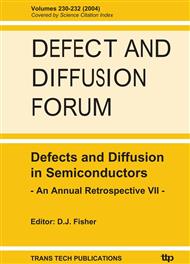p.81
p.93
p.101
p.111
p.125
p.135
p.149
p.177
p.199
Investigation and Identification of Transition Metals in p-Type Boron-Doped Silicon by Non-Invasive Techniques
Abstract:
This paper describes the “pairing - dissociation” behaviour of metal-acceptor pairs and proposes a method to measure metal concentrations in p-type boron doped silicon based on a contactless measurement technique. The first part of this paper sums up the previous non destructive electrical characterization methods that have led to the evaluation of iron concentrations in p-type boron- doped silicon by the inspired contactless techniques. It is demonstrated that the lifetime measurement method proposed allows the detection of contaminants at concentrations as low as 109at.cm-3. In the second part, the specific cases of iron and chromium that are among the most harmful metal contaminants are discussed. We show that these contaminants, even if their concentrations are not known, are identifiable by contactless measurements that allow the analysis of their kinetics of pairing with boron atoms and of their respective interactions with extended defects, such as grain boundaries in multicrystalline silicon.
Info:
Periodical:
Pages:
125-134
Citation:
Online since:
November 2004
Authors:
Price:
Сopyright:
© 2004 Trans Tech Publications Ltd. All Rights Reserved
Share:
Citation:


